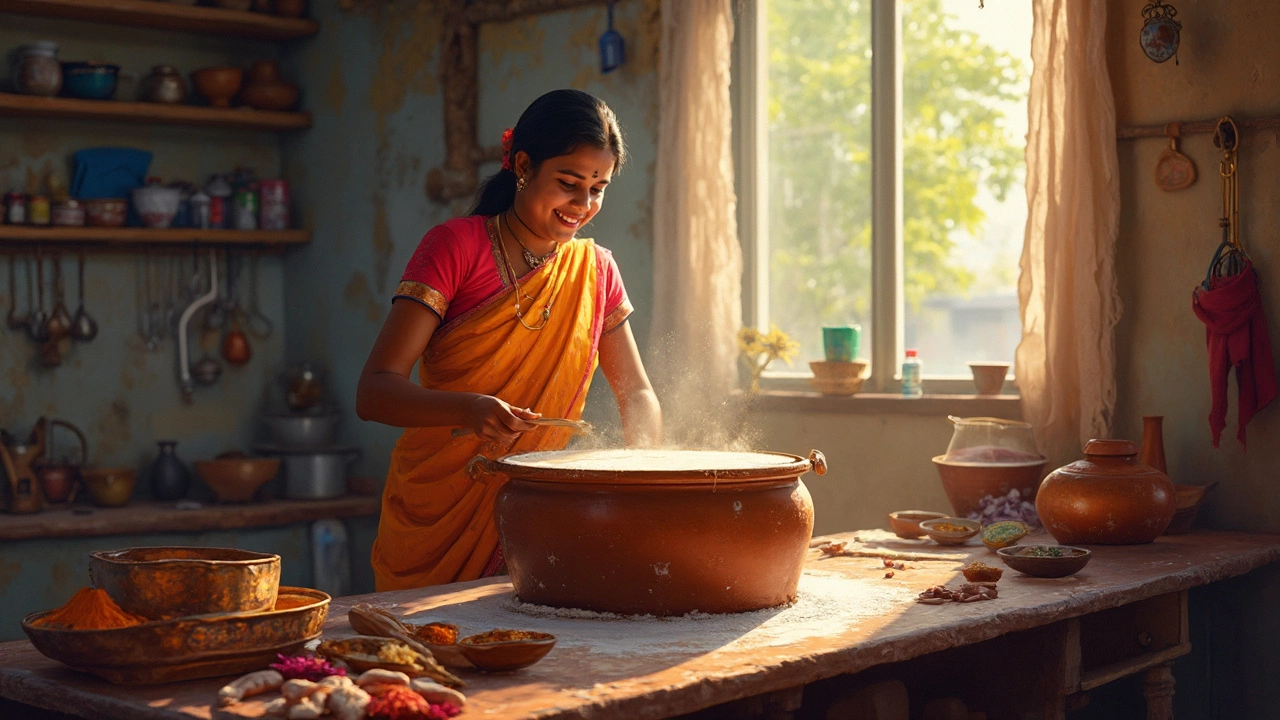If you've ever started your day with dreams of crispy, delightful dosas only to be met with a rubbery mess, you're definitely not alone. That's the breakfast buzzkill nobody wants. But once you know what’s causing this kitchen catastrophe, fixing it becomes a whole lot easier.
One of the biggest reasons your dosa batter feels like rubber instead of magic fluff could be fermentation—or rather, the lack of it. Fermenting the batter is key, letting those good bacteria get to work so the batter rises and gets that slight tangy aroma. If the weather's too cold or you’re rushing, this process might not complete, and that’s when things go downhill.
- Common Mistakes in Dosa Preparation
- Importance of Fermentation
- Right Ingredients and Ratios
- Mixing Techniques for Perfect Batter
- Temperature and Timing Tips
- Quick Fixes for Rubberiness
Common Mistakes in Dosa Preparation
Making the perfect dosa isn't just about tossing some ingredients together. A few common slip-ups can turn your crispy dreams into rubbery reality. Let’s get into what might be going wrong.
First off, the ratio of rice to lentils is crucial. You might think that more lentils would add more flavor, but overdoing it throws off the balance, leading to rubbery dosa. Stick to the classic ratio of roughly 3:1 (rice to lentils) to keep things on track.
Then there's the soaking time. Sure, it's easy to forget that bowl of rice and lentils soaking in the corner, but leaving them too long or not long enough messes with the texture. Aim for about 6-8 hours of soaking for a batter that behaves itself on the skillet.
Grinding can be another trouble spot. Whether you're using a traditional stone grinder or a modern blender, getting the consistency just right is key. Too coarse? You’re gonna end up wrestling with a lumpy batter. Super important: add water gradually to avoid a runny mix.
And, let's talk about fermentation. It's kind of like magic, you know? But it only works if you respect the process. Keep your batter in a warm place and give it about 8-12 hours to rise properly. If it's chilly out, try keeping it in the oven with the light on – neat trick!
Finally, let's not forget the cooking. Your dosa pan should be hot but not smoking. A sprinkle of water on the surface should sizzle and evaporate quickly. Also, don’t overdo the oil – too much and your dosa batter just swims around instead of crisping up nicely.
Importance of Fermentation
Fermentation gives your dosa batter that perfect lift and flavor. It’s like the secret handshake that unlocks crispy, delicious dosas instead of those dreaded rubbery ones. So, what exactly happens during this magical process?
Fermentation involves good bacteria breaking down the sugars in the rice and lentils used in your batter. This not only makes the mixture rise but also creates that distinctive tangy taste we love. Plus, it helps with digestion! According to food expert Sandor Katz, “Fermentation is empowering; it can transform a simple grain or pulse into something complex and aromatic.”
“Fermentation is empowering; it can transform a simple grain or pulse into something complex and aromatic.” – Sandor Katz, fermentation expert
Now, achieving the right level of fermentation isn't just about leaving your batter on the counter overnight. Temperature plays a huge role. If it’s chilly in your kitchen, try these tricks:
- Place your batter in an oven with just the light on, providing a gentle warmth.
- Wrap the container in a thick cloth to keep it cozy.
- Set it near the stove if you’ve been cooking other things to take advantage of the ambient heat.
Keep an eye on the batter, which should be slightly bubbly and risen after about 8 to 12 hours. Don't rush it, because partial fermentation can lead to those dreaded rubbery results.
Right Ingredients and Ratios
Getting the right mix of ingredients is like finding the secret to a perfect dosa. If you've ever wondered why some dosas turn into a rubbery disaster, the answer often lies in not having the correct ingredients and ratios down pat. So, let’s break it down.
First things first, you need the essentials: rice and urad dal, also known as black gram. But not just any rice will do. Opt for a short-grain rice, like sona masuri or parboiled rice, which brings out the right texture. For urad dal, it’s best to stick with whole or split dehusked urad dal. Forget kidney beans or other types, they won't create the same magic.
Now about those ratios. A 3:1 or 4:1 ratio of rice to urad dal is what most successful dosa-makers swear by. Too much dal, and you’ve got yourself a rubbery outcome. Too little, and the dosas get all grainy. Balance is key, people!
- Dosa batter ratio: 3 cups rice to 1 cup urad dal is a safe bet.
- Throw in about a tablespoon of fenugreek seeds; they add a bit of flavor and aid fermentation.
- If you’re feeling fancy, try a handful of poha (flattened rice) for extra crispiness.
Soak the rice and dal separately for at least 4 to 6 hours. Soaking correctly is half the battle won, believe it or not! Then, blend the dal until it’s smooth and frothy, adding just enough water to get it going. For the rice, you want it a bit grittier—not completely smooth.
Here’s a handy tip: when grinding, keep the water at a minimum, adding gradually. This prevents the batter from becoming too watery, which can also lead to those dreaded rubbery dosa results. And once you mix everything, let it sit for fermentation, which is kind of like letting the magic happen overnight.
To wrap it up, getting the right ingredients and ratios is crucial. Think of it as setting the stage for your dosa to dazzle. Once you've got that down, rubbery dosas will be a thing of the past, and you'll be the dosa master you always wanted to be!

Mixing Techniques for Perfect Batter
Getting the dosa batter just right is like nailing a dance move. It’s all about balance and technique. You might not think it, but the way you mix your ingredients can drastically affect the outcome of your dosas.
First up, the rice and lentils need some alone time—soaking separately for around 4-6 hours seems to be the sweet spot. This makes sure each grain absorbs sufficient water, setting you up for a smooth blend. After soaking, drain and blend them separately to a creamy texture, adding just enough water to help the process along.
Now, here's the trick with the actual mixing. When you mix these two batters together, make sure to fold them gently. Think of it like incorporating egg whites into a cake batter. Go easy and slow to keep the air in.
Want a pro-tip? Throw a handful of cooked rice or a tablespoon of poha (flattened rice) into the mix while grinding. It helps with fermentation and adds an extra fluffiness to your now perfect dosa batter.
- Soak rice and lentils separately.
- Blend them to a smooth paste individually.
- Mix gently to maintain airiness.
- Add cooked rice or poha for better fermentation.
By following these tips, your dosa batter should come out smooth, well-mixed, and ready to ferment to perfection. Remember, practice makes perfect, and with these steps, you're well on your way to dosa greatness!
Temperature and Timing Tips
Getting the temperature and timing right is like winning half the battle in making the perfect dosa batter. If your kitchen is cold, ferments can take forever, dragging your breakfast dreams along with them. So, what can you do to speed things up?
First off, consider the room temperature. Dosa batter loves a cozy, warm environment—much like you basking in sun rays on a cold day. Ideally, anywhere between 25-30°C (77-86°F) is golden for fermenting that batter like a pro.
If it’s winter or your kitchen is a fridge in disguise, try these hacks:
- Place the batter in your oven with just the light turned on. The light bulb gives off enough warmth to create a fermentation-friendly environment.
- Use a heating pad or a warm water bath. Put your batter bowl on a heating pad set to low or nestle it in a larger bowl with warm water.
Now, let's talk timing. How long you let the batter hang out is crucial. It usually takes about 8 to 12 hours for optimal fermentation. But don't set it and forget it! The clock isn’t universal. Weather and ingredient freshness can play tricks.
Wanna know if you hit the jackpot? Look for bubbles and a rise in the batter volume. It should smell slightly sour too. If it’s all these, congrats, your dosa batter is ready. Otherwise, give it a little more time. Just remember, patience is the best spice here.
With these temperature and timing tips up your sleeve, your rubbery dosa days are numbered. Pretty soon, you'll be dishing out those golden, crispy wonders like a total dosa ninja.
Quick Fixes for Rubberiness
Got a batch of dosa batter that turned out rubbery? Don't worry, you can often salvage it with a few tweaks without chucking the whole thing out.
First, check the fermentation. If you're in a cold area, try keeping the batter in a warm space. A neat trick: Pop it in the oven with just the light on—no heat. That little extra warmth can make a big difference.
Sometimes, adding a little bit of water can do wonders. Carefully stir in a few tablespoons of water to slightly thin the batter. This can help restore the spreadability and improve the texture of your dosa.
- Increase Fermentation: If possible, let it ferment for a bit longer. Warmer settings speed up the process, helping achieve that optimal fluffy texture.
- Boost the Moisture: Adding a simple splash of water can help improve consistency, making it less rubbery while cooking.
- Use a Dosa Buddy: Adding a handful of cooked rice or poha (flattened rice) into the batter mix before fermenting can solve the tough texture issue. These help bring softness to the batter once cooked.
- Pancake Mix Rescue: If all fails, cheat a little. Mix in a spoonful of all-purpose flour or readymade pancake mix. It can quickly adjust the texture, though it's best reserved for emergencies.
These quick fixes can help save your breakfast plans without sacrificing too much time or effort. With practice, you'll be rolling the perfect dosa in no time.
